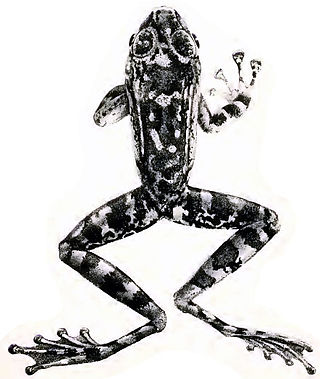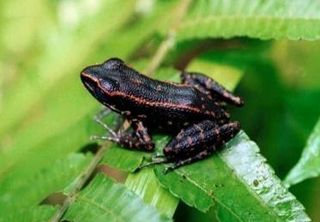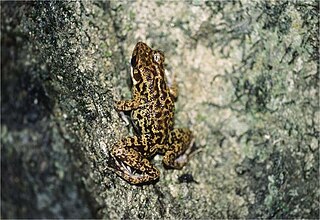Pelophryne signata is a species of toad in the family Bufonidae. It is found in Brunei, Malaysia, and possibly Indonesia. Its natural habitats are subtropical or tropical moist lowland forests and freshwater marshes. It is threatened by habitat loss.

Xenophrys aceras, commonly known as the Perak horned toad, Perak spadefoot toad or Malayan horned frog, is a species of frog in the family Megophryidae found in Peninsular Malaysia and Thailand, and possibly in Indonesia. Its common name refers to its type locality, Bukit Besar in Perak state, Malaysia.

The palmated chorus frog is a species of frog in the family Microhylidae. It is found in Indonesia and Malaysia. Its natural habitats are subtropical or tropical moist lowland forests, rivers, and freshwater marshes. It is not considered threatened by the IUCN.

Amolops larutensis is a species of frog in the family Ranidae that is found in the Malay Peninsula from southernmost Thailand to Malaysia; records further north probably represent A. panhai.

Limnonectes paramacrodon is a species of frog in the family Dicroglossidae. It is found in Malay Peninsula, Borneo, and Natuna Besar. Its natural habitats are lowland swamp forest areas with small rivers and streams. It is becoming rare due to habitat loss.

Meristogenys orphnocnemis is a species of frog in the family Ranidae, sometimes known as Sabah Borneo frog or dusky-footed torrent frog. It is endemic to Borneo and found in the mountains of Sabah (Malaysia), Brunei, and East Kalimantan (Indonesia). Its natural habitats are hilly lowland rainforest, also occurring in slightly disturbed forests. Tadpoles live in clear, rocky forest streams where they cling to rocks in strong currents. Siltation of streams caused by deforestation is a threat to this species.

The common green frog is a frog species of in the true frog family Ranidae; some sources still use the old name Rana erythraea. It lives in Southeast Asia and is also known as green paddy frog, red-eared frog or leaf frog. The last name, however, commonly refers to the Neotropical tree frogs which make up the subfamily Phyllomedusinae. These are not closely related to H. erythraea, belonging to family Hylidae instead.

Pulchrana siberu, also known as the Siberut Island frog, is a species of true frog, family Ranidae. It is found in the Mentawai Islands, off the Sumatran west coast (Indonesia), including the eponymous Siberut Island. It possibly occurs in Sumatra itself, although the latter records seem to refer to an as-yet-undescribed species. Similarly, earlier records from Malaysia refer to Pulchrana centropeninsularis.

Pulchrana baramica, the Baram River frog, brown marsh frog, or masked rough-sided frog, is a species of "true frog", family Ranidae. It is found in the Malay Peninsula, including the extreme south Thailand, Peninsular Malaysia, and Singapore, and in the Malay Archipelago, including Borneo, and the Indonesian islands Java, Sumatra, and Bangka Island. Its type locality is the Baram River in Sarawak, Malaysia, giving it one of its common names. Its natural habitats are tropical moist lowland forests and swamps. It is not considered threatened by the IUCN.

Pulchrana picturata, also known as the spotted stream frog, is a species of frog in the family Ranidae. It is endemic to Borneo.
Pulchrana banjarana is a species of true frogs, family Ranidae. It is endemic to the Malay Peninsula, occurring from the extreme southern Thailand to Peninsular Malaysia; however, it might also occur in Sumatra (Indonesia). The specific name banjarana is derived from the Malay word for "mountain range", banjaran, and refers to the distribution of this species in the highlands of the Malay Peninsula.
Pulchrana debussyi is a species of true frog, family Ranidae. It is endemic to Sumatra, Indonesia. It is only known from its type locality in the Batak Mountains. The holotype is now lost, and there are concerns about validity of this taxon—it might be a synonym of Sylvirana nigrovittata. Common name Battak frog has been proposed for it.

Pulchrana grandocula, also known as the big-eyed frog, is a species of "true frog", family Ranidae. It is endemic to the southern Philippines and occurs on the islands of Basilan, Bohol, Camiguin Sur, Dinagat, Samar, Siargao, Bucas Grande, and Mindanao. Some populations from Mindanao formerly assigned to this species are now recognized as a separate species, Pulchrana guttmani.
Pulchrana laterimaculata, also known as the side-spotted swamp frog, is a species of "true frog", family Ranidae. It is found on the Malay Peninsula from the southernmost Thailand through Malaysia to Singapore, in Sarawak in Borneo, and on the Natuna Besar island in the Indonesian part of the South China Sea.
Pulchrana melanomenta is a species of "true frog" in the family Ranidae. It is endemic to the Sulu Archipelago of the Philippines. It occurs in undisturbed and disturbed streams and rivers in lower montane and lowland forests. Breeding probably takes place in streams. It is potentially threatened by deforestation (logging) and by habitat conversion to agriculture, expanding human settlements, and nickel mining.

Pulchrana moellendorffi, also known as the Culion frog, is a species of "true frog", family Ranidae. It is endemic to the Palawan Island group of the Philippines. It inhabits streams and rivers in lower montane and lowland forests. It is threatened by habitat loss.

Pulchrana mangyanum is a species of "true frog", family Ranidae. It is endemic to the Philippines and occurs on Mindoro, Sibay, and Semirara islands. Prior to its description in 2002, Pulchrana mangyanum was confused with Pulchrana signata.
Pulchrana fantastica, also known as the splendid stream frog, is a species of "true frog", family Ranidae. It is endemic to northern Sumatra (Indonesia) and is currently known from the Aceh and North Sumatra provinces. Its nearest relatives are Pulchrana centropeninsularis and Pulchrana siberu. The specific name fantastica is derived from the Greek phantastikós and refers to the "extraordinary beauty" of this frog.
Pulchrana centropeninsularis is a species of "true frog", family Ranidae. It is found in Peninsular Malaysia and Sumatra (Indonesia). The specific name centropeninsularis refers to the area of its original discovery, the state of Pahang in the central Peninsular Malaysia. Later on, it has also been recorded in the province of Jambi in east-central Sumatra. Pulchrana centropeninsularis is a rare species known from few individuals only. Prior to its description, Pulchrana centropeninsularis was confused with Pulchrana siberu, its closest relative.













